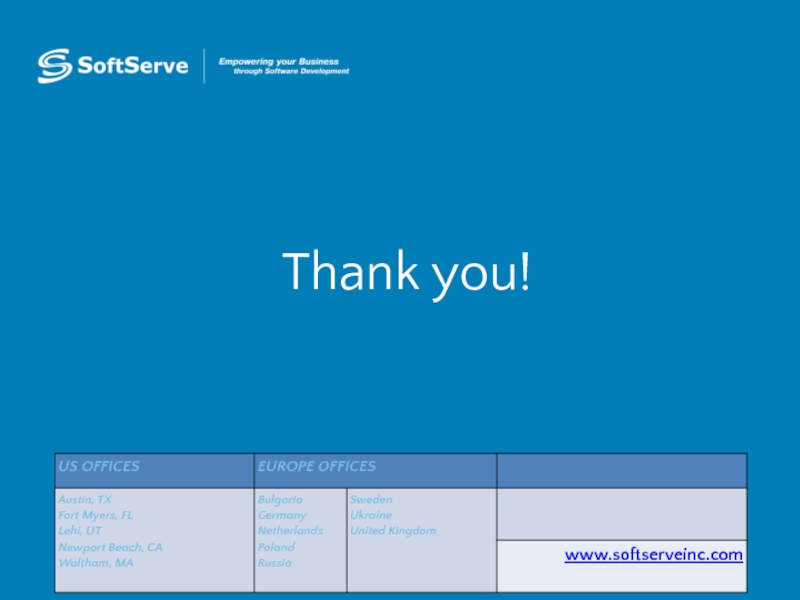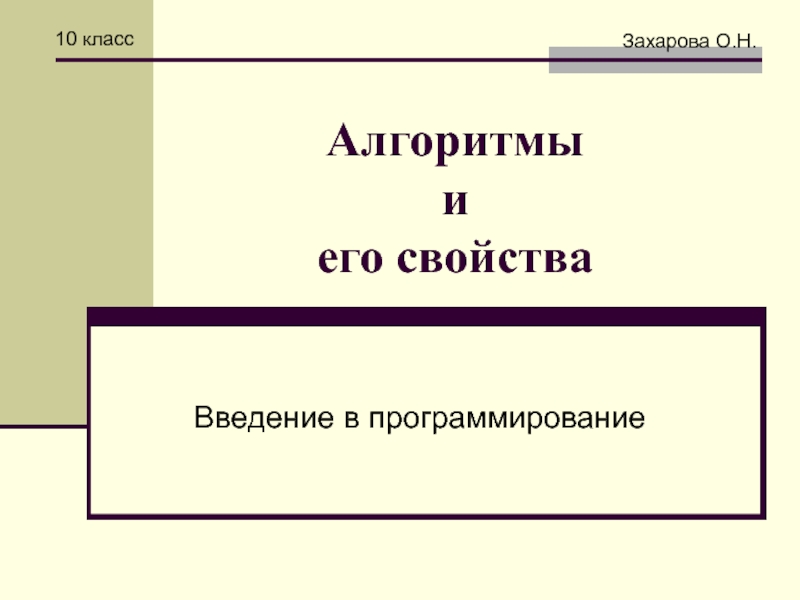- Главная
- Разное
- Дизайн
- Бизнес и предпринимательство
- Аналитика
- Образование
- Развлечения
- Красота и здоровье
- Финансы
- Государство
- Путешествия
- Спорт
- Недвижимость
- Армия
- Графика
- Культурология
- Еда и кулинария
- Лингвистика
- Английский язык
- Астрономия
- Алгебра
- Биология
- География
- Детские презентации
- Информатика
- История
- Литература
- Маркетинг
- Математика
- Медицина
- Менеджмент
- Музыка
- МХК
- Немецкий язык
- ОБЖ
- Обществознание
- Окружающий мир
- Педагогика
- Русский язык
- Технология
- Физика
- Философия
- Химия
- Шаблоны, картинки для презентаций
- Экология
- Экономика
- Юриспруденция
Design patterns. GoF for .Net developers презентация
Содержание
- 1. Design patterns. GoF for .Net developers
- 2. History What is patterns? The most uses
- 3. History
- 4. Patterns originated as an architectural concept by
- 5. What is patterns?
- 6. Design patterns represent the best practices used
- 7. Any pattern describes the problem that arises
- 8. Design Patterns are divided into groups Creational
- 9. Structural patterns. These concern class and object
- 10. Singleton
- 11. In software engineering, the singleton pattern is
- 12. Sigleton: Example class MainClass { public static
- 13. Factory Method
- 14. Factory pattern is one of most used
- 15. We're going to create a Mechanism interface
- 16. Factory Method: Example public interface Mechanism {
- 17. Factory Method: Example public class MechanismFactory {
- 18. Factory Method: Example public class Trebuchet :
- 19. Abstract Factory
- 20. Abstract Factory patterns work around a super-factory
- 21. We are going to create a Race
- 22. Abstract Factory: Example public interface Race {
- 23. Abstract Factory: Example public interface Army {
- 24. Factory Method: Example public class Warior :
- 25. Abstract Factory: Example public abstract class AbstractFactory
- 26. Factory Method: Example public class ArmyFactory :
- 27. Factory Method: Example public class RaceFactory :
- 28. Factory Method: Example class MainClass { public
- 29. Builder
- 30. Builder pattern builds a complex object using
- 31. We have considered a case of army
- 32. Builder: Example public interface Stack { String
- 33. Builder: Example public class ElfesHeroe : Heroes
- 34. Builder: Example public class Archers : Platoon
- 35. Builder: Example public interface Movement { String
- 36. Builder: Example public class Army { private
- 37. Builder: Example public class ArmyBuilder { public
- 38. Builder: Example class MainClass { public static
- 39. Adapter
- 40. Adapter pattern works as a bridge between
- 41. We have a NatureSpells interface and a
- 42. Adapter: Example public interface NatureSpells { void
- 43. Adapter: Example public interface MoreSpells { void
- 44. Adapter: Example public class SpellsAdapter : NatureSpells
- 45. Adapter: Example class MainClass { public static
- 46. Bridge
- 47. Bridge is used when we need to
- 48. We have a PlatoonAPI interface which is
- 49. Bridge: Example public abstract class Platoon {
- 50. Bridge: Example public class Archer : Platoon
- 51. Facade
- 52. Facade pattern hides the complexities of the
- 53. We are going to create a Hero
- 54. Facade: Example public class Crusader : Hero
- 55. Facade: Example public class HeroeFacade { private
- 56. Facade: Example class MainClass { public static
- 57. Composite
- 58. Composite pattern is used where we need
- 59. We have a class Heroes which acts
- 60. Composite: Example public class Heroes { private
- 61. Composite: Example class MainClass { public static
- 62. … Console.WriteLine (armyCommander); foreach
- 63. Iterator
- 64. Iterator pattern is very commonly used design
- 65. We're going to create a abstract class
- 66. Iterator: Example abstract class Aggregate { public
- 67. Iterator: Example class HeroesIterator : Iterator {
- 68. Iterator: Example class MainClass { public static
- 69. Thank you!
Слайд 2History
What is patterns?
The most uses GoF patterns:
Singleton;
Factory Method;
Abstract Factory;
Builder;
Adapter;
Bridge;
Facade;
Composite;
Iterator.
Agenda
Слайд 4Patterns originated as an architectural concept by Christopher Alexander (1977/79). In
Design patterns gained popularity in computer science after the book Design Patterns: Elements of Reusable Object-Oriented Software was published in 1994 by the so-called "Gang of Four" (Gamma et al.), which is frequently abbreviated as “GoF".
Although design patterns have been applied practically for a long time, formalization of the concept of design patterns languished for several years.
History
Слайд 6Design patterns represent the best practices used by experienced object-oriented software
Design pattern – a description of the interaction of objects and classes that are adapted to solve the general problem of designing in context.
What is patterns?
Слайд 7Any pattern describes the problem that arises again and again in
In general, pattern consists of four main elements:
Name. Referring to it, we can immediately describe the problem, designing of, and its decisions and their consequences. Assigning names of patterns allows design at a higher level of abstraction.
Problem. A description of when to apply the pattern. Necessary to formulate the problem and its context.
Solution. Description of design elements, relations between them, the functions each item.
The Results – a consequence of the pattern. In describing the impact of design decisions are often not mentioned. You must choose between different options and evaluate the advantages and disadvantages of the pattern.
What is patterns?
Слайд 8Design Patterns are divided into groups
Creational patterns are ones that create
Abstract Factory groups object factories that have a common theme.
Builder constructs complex objects by separating construction and representation.
Factory Method creates objects without specifying the exact class to create.
Prototype creates objects by cloning an existing object.
Singleton restricts object creation for a class to only one instance.
Behavioral patterns. Most of these design patterns are specifically concerned with communication between objects.
Chain of responsibility delegates commands to a chain of processing objects.
Iterator accesses the elements of an object sequentially without exposing its underlying representation.
Observer is a publish/subscribe pattern which allows a number of observer objects to see an event.
What is patterns?
Слайд 9Structural patterns. These concern class and object composition. They use inheritance
Adapter allows classes with incompatible interfaces to work together by wrapping its own interface around that of an already existing class.
Bridge decouples an abstraction from its implementation so that the two can vary independently.
Composite composes zero-or-more similar objects so that they can be manipulated as one object.
Decorator dynamically adds/overrides behaviour in an existing method of an object.
Facade provides a simplified interface to a large body of code.
Proxy provides a placeholder for another object to control access, reduce cost, and reduce complexity.
Design patterns reside in the domain of modules and interconnections. At a higher level there are architectural patterns that are larger in scope, usually describing an overall pattern followed by an entire system.
What is patterns?
Слайд 11In software engineering, the singleton pattern is a design pattern that
Singleton
Слайд 12Sigleton: Example
class MainClass
{
public static void Main (string[] args)
{
SingletoneObject obj = SingletoneObject.getInstance
public class SingletoneObject
{
private static SingletoneObject instance = new SingletoneObject();
private SingletoneObject(){}
public static SingletoneObject getInstance()
{
return instance;
}
public void showMessage()
{
Console.WriteLine("Hello Singletone!");
}
}
SingletoneObject.cs
Program.cs
Слайд 14Factory pattern is one of most used design pattern. In Factory
Factory method
Слайд 15We're going to create a Mechanism interface and concrete classes implementing
MainClass, our demo class will use MechanismFactory to get a Mechanism object. It will pass information (BALLISTA / CATAPULT / TREBUCHET) to MechanismFactory to get the type of object it needs.
Factory Method: Example
Слайд 16Factory Method: Example
public interface Mechanism
{
void choice();
}
public class Ballista : Mechanism
{
public Ballista
public class Catapult : Mechanism
{
public Catapult ()
{
}
public void choice ()
{
Console.WriteLine ("Choised Catapult");
}
}
Mechahism.cs
Ballista.cs
Catapult.cs
Слайд 17Factory Method: Example
public class MechanismFactory
{
public MechanismFactory ()
{
}
public Mechanism getMechanism(String mechanismType)
{
if (mechanismType
MechanismFactory.cs
Слайд 18Factory Method: Example
public class Trebuchet : Mechanism
{
public Trebuchet ()
{
}
public void choice
class MainClass
{
public static void Main (string[] args)
{
MechanismFactory mechanismFactory = new MechanismFactory ();
Mechanism mechanism1 = mechanismFactory.getMechanism ("catapult");
mechanism1.choice ();
Mechanism mechanism2 = mechanismFactory.getMechanism ("ballista");
mechanism2.choice ();
Mechanism mechanism3 = mechanismFactory.getMechanism ("trebuchet");
mechanism3.choice ();
}
}
Trebuchet.cs
MainClass.cs
Слайд 20Abstract Factory patterns work around a super-factory which creates other factories.
In
Abstract Factory
Слайд 21We are going to create a Race and Army interfaces and
MainClass, our demo class uses FactoryProducer to get a AbstractFactory object. It will pass information (ORKS / ELVES / DWARFS for Race) to AbstractFactory to get the type of object it needs. It also passes information (WARIOR / ARCHER / CAVALARY for Army) to AbstractFactory to get the type of object it needs.
Abstract Factory: Example
Слайд 22Abstract Factory: Example
public interface Race
{
void whoAmI();
}
public class Orks : Race
{
public Orks
public class Elves : Race
{
public Elves ()
{
}
void Race.whoAmI()
{
Console.WriteLine ("I am Elve");
}
}
Race.cs
Orks.cs
Elves.cs
Слайд 23Abstract Factory: Example
public interface Army
{
void setType();
}
public class Archer : Army
{
public Archer
public class Dwarfs : Race
{
public Dwarfs ()
{
}
void Race.whoAmI()
{
Console.WriteLine ("I am Dwarf");
}
}
Army.cs
Archer.cs
Dwarfs.cs
Слайд 24Factory Method: Example
public class Warior : Army
{
public Warior ()
{
}
void Army.setType()
{
Console.WriteLine ("My
public class Cavalary : Army
{
public Cavalary ()
{
}
void Army.setType()
{
Console.WriteLine ("My type is Cavalary");
}
}
Warior.cs
Cavalary.cs
Слайд 25Abstract Factory: Example
public abstract class AbstractFactory
{
abstract public Race getRace(String race);
abstract public
public class FactoryProducer
{
public static AbstractFactory getFactory(String choice)
{
if (choice.ToUpper() == "RACE") {
return new RaceFactory ();
} else if (choice.ToUpper() == "ARMY") {
return new ArmyFactory ();
}
return null;
}
}
AbstractFactory.cs
FactoryProducer.cs
Слайд 26Factory Method: Example
public class ArmyFactory : AbstractFactory
{
override public Race getRace (string
ArmyFactory.cs
Слайд 27Factory Method: Example
public class RaceFactory : AbstractFactory
{
override public Race getRace(String raceType)
{
if
RaceFactory.cs
Слайд 28Factory Method: Example
class MainClass
{
public static void Main (string[] args)
{
AbstractFactory raceFactory =
MainClass.cs
Слайд 30Builder pattern builds a complex object using simple objects and using
A Builder class builds the final object step by step. This builder is independent of other objects.
Builder
Слайд 31We have considered a case of army stack forming where a
We are going to create an Stack interface representing stack of army such as heros and platoons and concrete classes implementing the Stack interface and a Movement interface representing type of army moving and concrete classes implementing the Movement interface as hero would be move by a horse and platoon would be move afoot.
We then create a Army class having List of Stack and a ArmyBuilder to build different types of Army objects by combining Stack. MainClass, our demo class will use ArmyBuilder to build a Army.
Builder: Example
Слайд 32Builder: Example
public interface Stack
{
String name ();
Movement movement ();
int dexterity ();
}
public abstract
Stack.cs
Heroes.cs
public abstract class Platoon : Stack
{
public abstract String name();
public Movement movement()
{
return new Afoot ();
}
public abstract int dexterity();
}
Platoon.cs
Слайд 33Builder: Example
public class ElfesHeroe : Heroes
{
public override int dexterity()
{
return 7;
}
public override
public class DwarfHero : Heroes
{
public override int dexterity()
{
return 4;
}
public override String name()
{
return "Darf Heroe";
}
}
ElfesHeroe.cs
DwarfHero.cs
Слайд 34Builder: Example
public class Archers : Platoon
{
public override int dexterity()
{
return 4;
}
public override
public class Wariors : Platoon
{
public override int dexterity()
{
return 2;
}
public override String name()
{
return "Wariors Platoon";
}
}
Archers.cs
Wariors.cs
Слайд 35Builder: Example
public interface Movement
{
String setMovement();
}
public class Afoot : Movement
{
public String setMovement()
{
return
Movement.cs
Afoot.cs
public class Horse : Movement
{
public String setMovement()
{
return "Horse";
}
}
Horse.cs
Слайд 36Builder: Example
public class Army
{
private List stacks = new List ();
public void
Army.cs
Слайд 37Builder: Example
public class ArmyBuilder
{
public Army prepareDwarfsWariors()
{
Army army = new Army ();
army.addStack
ArmyBuilder.cs
Слайд 38Builder: Example
class MainClass
{
public static void Main (string[] args)
{
ArmyBuilder armyBuild = new
MainClass.cs
Слайд 40Adapter pattern works as a bridge between two incompatible interfaces. This
Adapter
Слайд 41We have a NatureSpells interface and a concrete class Mage implementing
We are having another interface MoreSpells and concrete classes implementing the MoreSpells interface. These classes define the other type of spells.
We want to make Mage to cast other spells as well. To attain this, we have created an adapter class SpellsAdapter which implements the NatureSpells interface and uses MoreSpells objects to cast the required spell.
Mage uses the adapter class SpellsAdapter passing it the desired spell type without knowing the actual class which can cast the desired spell. MainClass, our demo class will use Mage class to play various spells.
Adapter: Example
Слайд 42Adapter: Example
public interface NatureSpells
{
void cast(String typeSpell, String nameSpell);
}
public class Mage :
NatureSpells.cs
Mage.cs
Слайд 43Adapter: Example
public interface MoreSpells
{
void castFireSpell(String nameSpell);
void castWaterSpell(String nameSpell);
}
public class FireSpells :
MoreSpells.cs
FireSpells.cs
public class WaterSpells : MoreSpells
{
public void castFireSpell(String nameSpell) { }
public void castWaterSpell(String nameSpell)
{
Console.WriteLine ("Use water spell: " + nameSpell);
}
}
WaterSpells.cs
Слайд 44Adapter: Example
public class SpellsAdapter : NatureSpells
{
MoreSpells moreSpellsForHeroe;
public SpellsAdapter (String typeSpell)
{
if (typeSpell.ToUpper
SpellsAdapter.cs
Слайд 45Adapter: Example
class MainClass
{
public static void Main (string[] args)
{
Mage greatMage = new
MainClass.cs
Слайд 47Bridge is used when we need to decouple an abstraction from
This pattern involves an interface which acts as a bridge which makes the functionality of concrete classes independent from interface implementer classes. Both types of classes can be altered structurally without affecting each other.
Bridge
Слайд 48We have a PlatoonAPI interface which is acting as a bridge
MainClass, our demo class will use Platoon class to draw different archer type.
Bridge: Example
public interface PlatoonAPI
{
void abilityPlatoon(int dexterity, int accuracy, int wisdom);
}
PlatoonAPI.cs
Слайд 49Bridge: Example
public abstract class Platoon
{
protected PlatoonAPI platoonAPI;
public abstract void ability();
}
public class
MoreSpells.cs
EliteArcher.cs
public class SharpShooter : PlatoonAPI
{
public void abilityPlatoon(int dexterity, int accuracy, int wisdom)
{
Console.WriteLine ("Platoon type: 'Sharpshooter';");
Console.WriteLine ("Ability:");
Console.WriteLine ("Dexterity: " + dexterity);
Console.WriteLine ("Wisdom: " + wisdom);
Console.WriteLine ("Accuracy: " + accuracy);
}
}
SharpShooter.cs
Слайд 50Bridge: Example
public class Archer : Platoon
{
private int dexterity, accuracy, wisdom;
public Archer
class MainClass
{
public static void Main (string[] args)
{
Platoon eliteArcher = new Archer (3, 2, 1, new EliteArcher ());
Platoon sharpShooter = new Archer (5, 7, 2, new SharpShooter ());
eliteArcher.ability ();
sharpShooter.ability ();
}
}
Archer.cs
MainClass.cs
Слайд 52Facade pattern hides the complexities of the system and provides an
Facade
Слайд 53We are going to create a Hero interface and concrete classes
HeroeFacade class uses the concrete classes to delegate user calls to these classes. MainClass, our demo class, will use HeroeFacade class to show the results.
Facade: Example
public interface Hero
{
void chooseHero ();
}
Hero.cs
Слайд 54Facade: Example
public class Crusader : Hero
{
public void chooseHero ()
{
Console.WriteLine ("Your choose
public class Barbarian : Hero
{
public void chooseHero ()
{
Console.WriteLine ("Your choose is 'Barbarian'");
}
}
Crusader.cs
Barbarian.cs
public class Wizard : Hero
{
public void chooseHero ()
{
Console.WriteLine ("Your choose is 'Wizard'");
}
}
Wizard.cs
Слайд 55Facade: Example
public class HeroeFacade
{
private Hero barbarian;
private Hero crusader;
private Hero wizard;
public HeroeFacade
HeroeFacade.cs
Слайд 56Facade: Example
class MainClass
{
public static void Main (string[] args)
{
HeroeFacade facade = new
MainClass.cs
Слайд 58Composite pattern is used where we need to treat a group
This pattern creates a class that contains group of its own objects. This class provides ways to modify its group of same objects.
Composite
Слайд 59We have a class Heroes which acts as composite pattern actor
Composite: Example
Слайд 60Composite: Example
public class Heroes
{
private String name;
private String race;
private String stack;
private List
Heroes.cs
Слайд 61Composite: Example
class MainClass
{
public static void Main (string[] args)
{
Heroes armyCommander = new
MainClass.cs
Слайд 62…
Console.WriteLine (armyCommander);
foreach (Heroes armyHead in armyCommander.getSubordinates())
{
Console.WriteLine (armyHead);
foreach (Heroes army in armyHead.getSubordinates())
{
Console.WriteLine
MainClass.cs
Слайд 64Iterator pattern is very commonly used design pattern in .Net programming
Iterator
Слайд 65We're going to create a abstract class Iterator which narrates navigation
MainClass, our demo class will use HeroesAggregate, a concrete class implementation to print a Names of heroes stored as a collection in HeroesAggregate.
Iterator: Example
abstract class Iterator
{
public abstract object First();
public abstract object Next();
public abstract bool IsDone();
public abstract object CurrentItem();
}
Iterator.cs
Слайд 66Iterator: Example
abstract class Aggregate
{
public abstract Iterator CreateIterator();
}
class HeroesAggregate : Aggregate
{
private ArrayList
Aggregate.cs
HeroesAggregate.cs
Слайд 67Iterator: Example
class HeroesIterator : Iterator
{
private HeroesAggregate aggregate;
private int current = 0;
public
Archer.cs
Слайд 68Iterator: Example
class MainClass
{
public static void Main (string[] args)
{
HeroesAggregate heroesStack = new
MainClass.cs
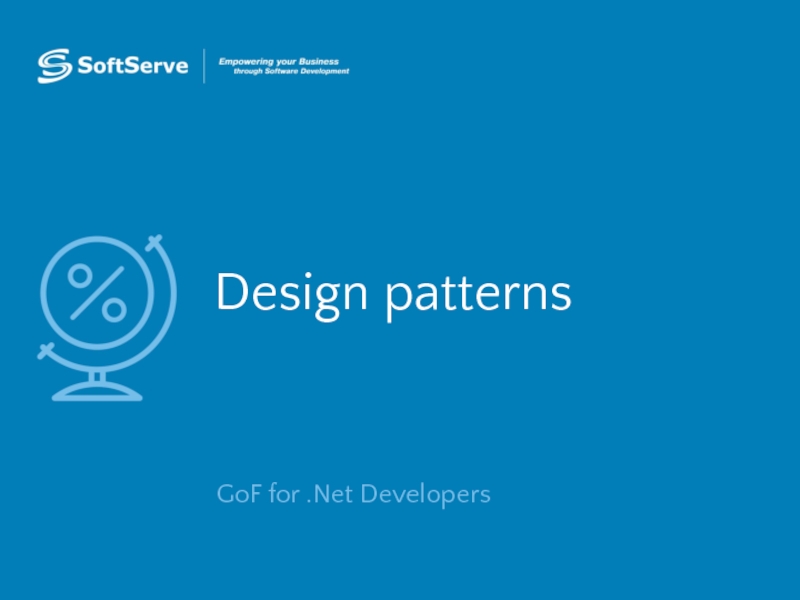
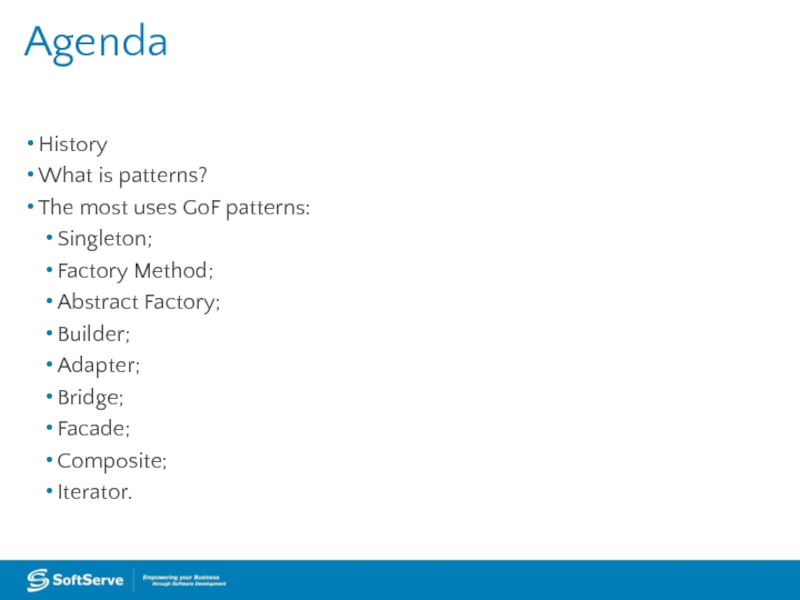

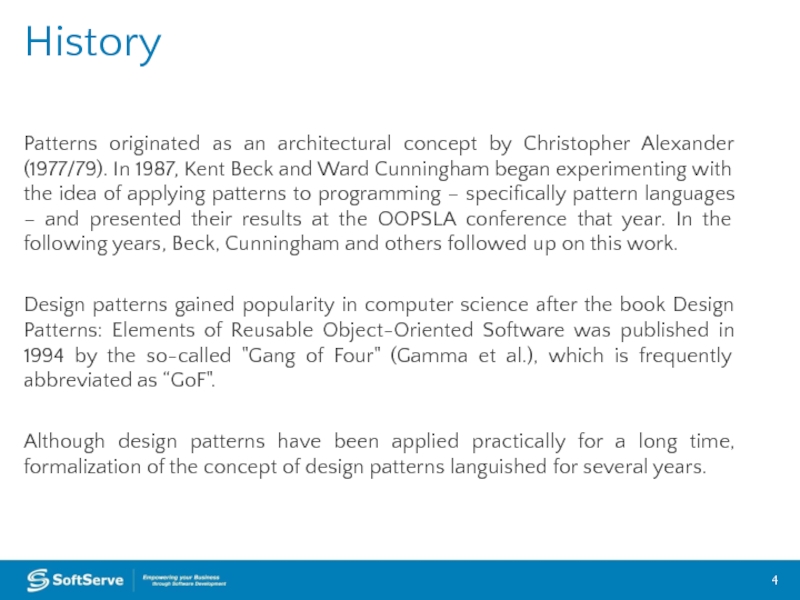
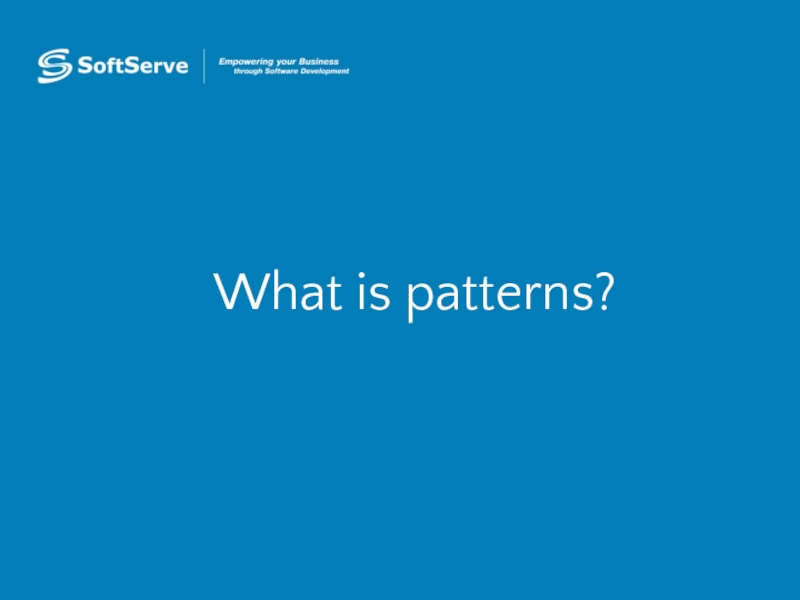
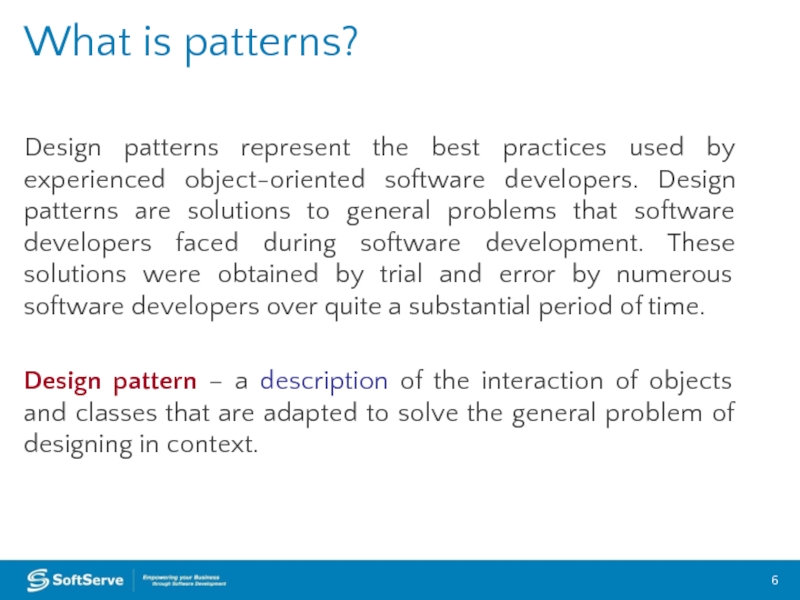

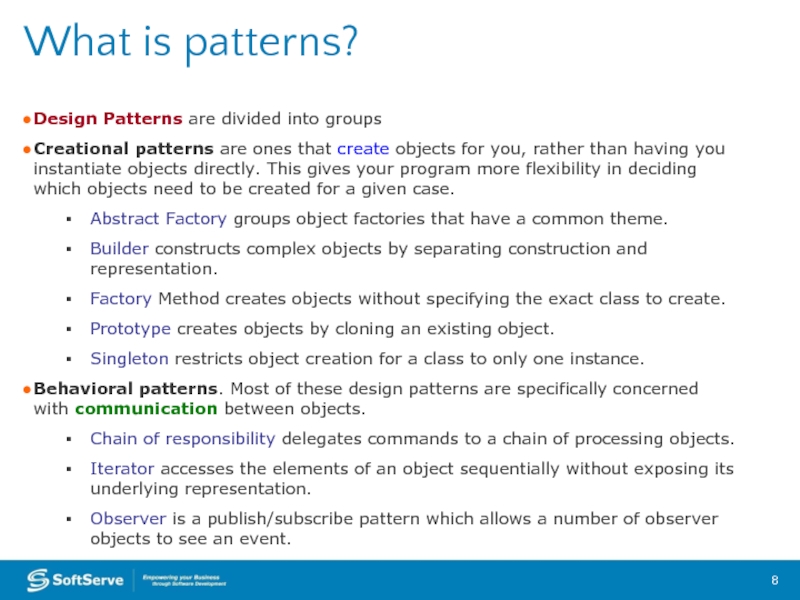
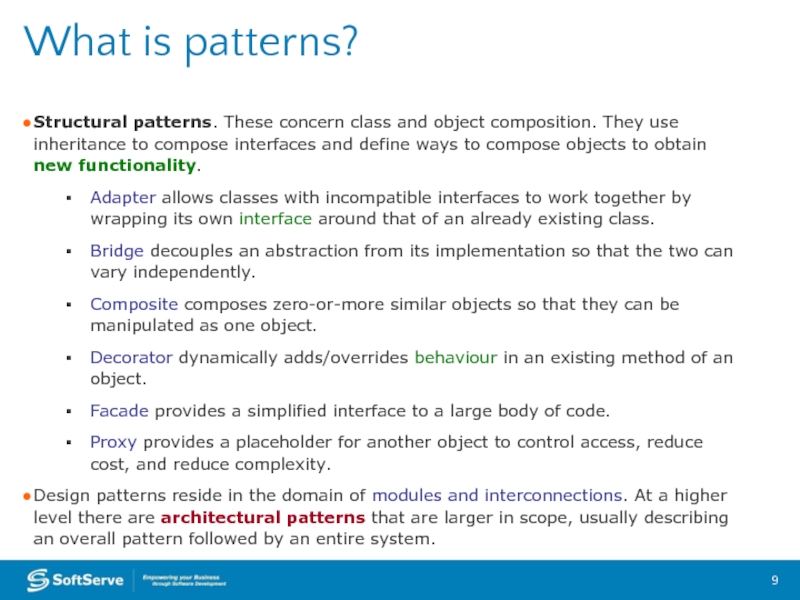

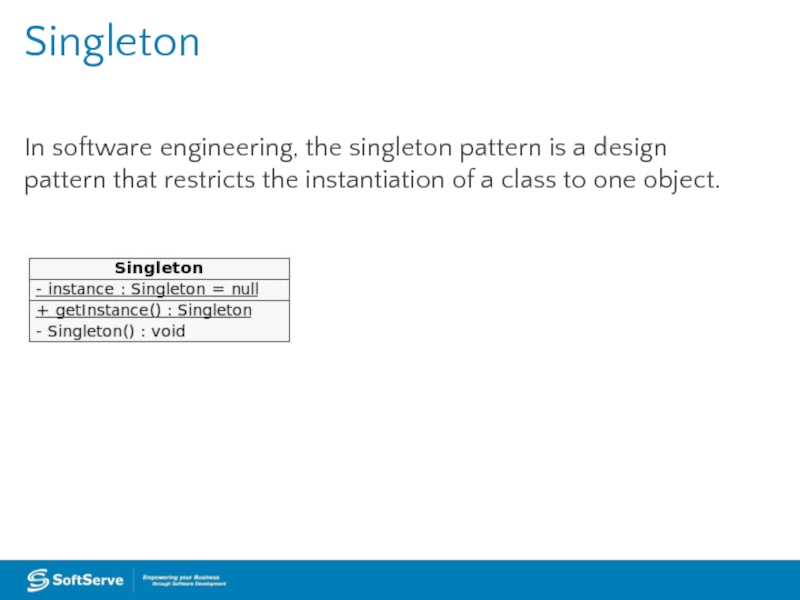
![Sigleton: Exampleclass MainClass { public static void Main (string[] args) { SingletoneObject obj = SingletoneObject.getInstance](/img/tmb/5/441973/c9e8c02eb44a5a06d22b1fb9667c8975-800x.jpg)

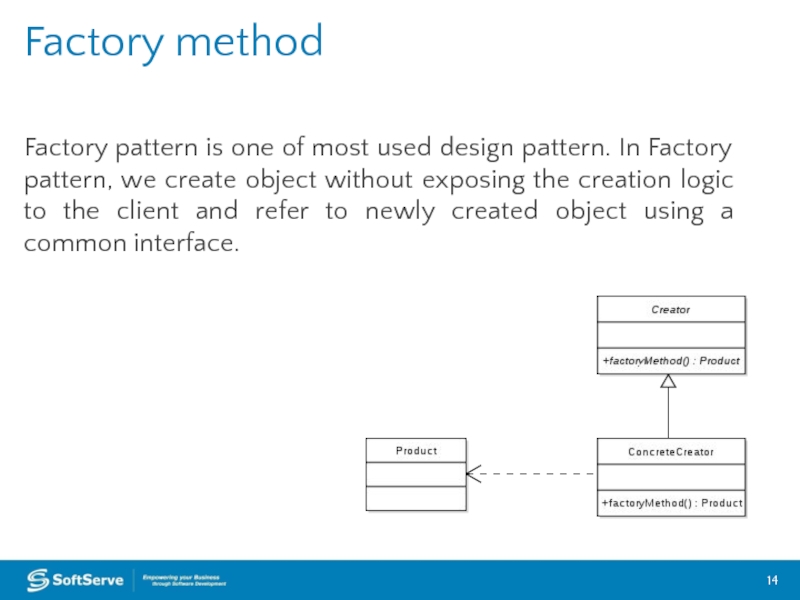
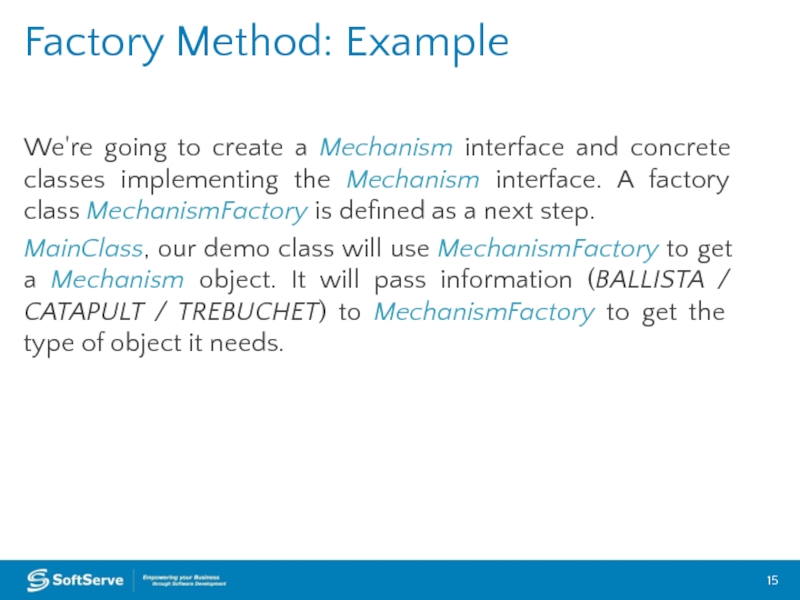
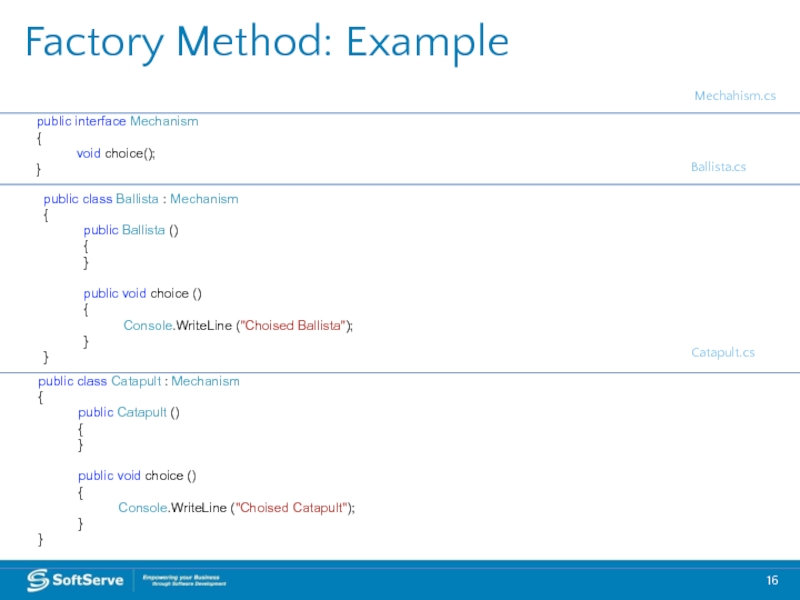
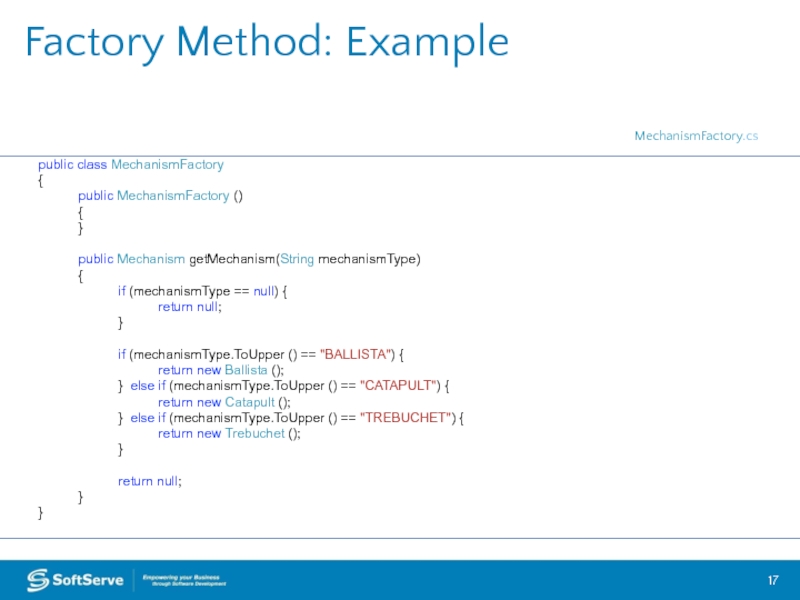
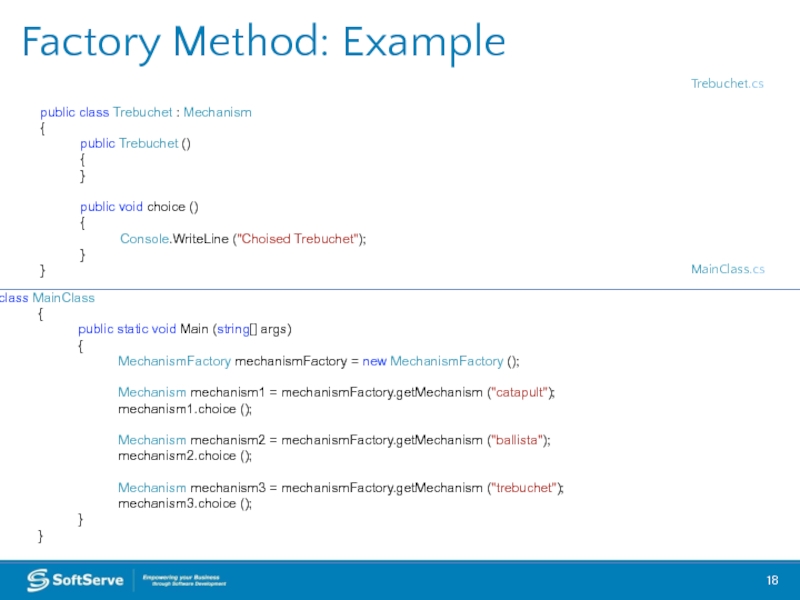

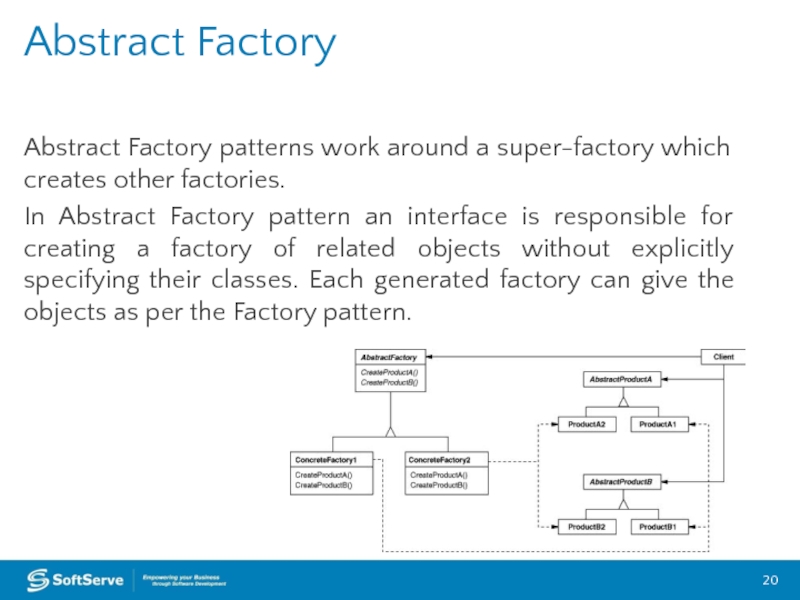
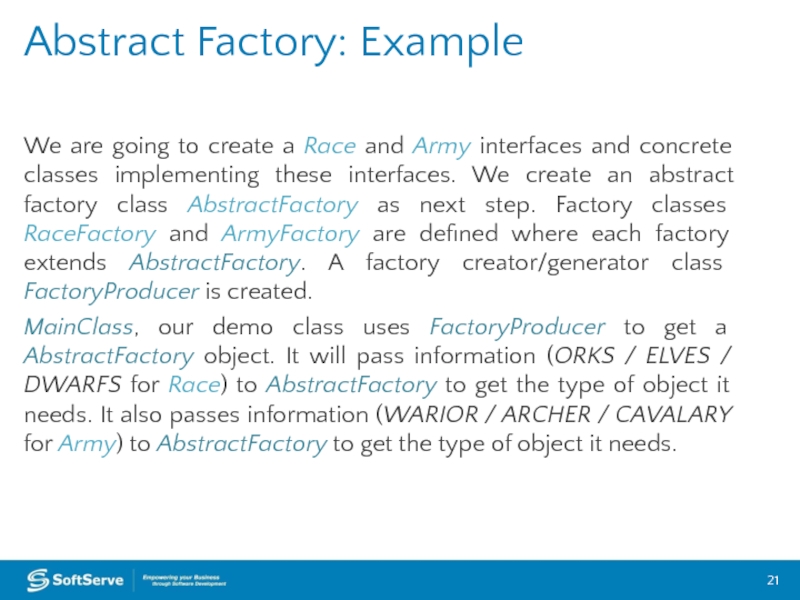
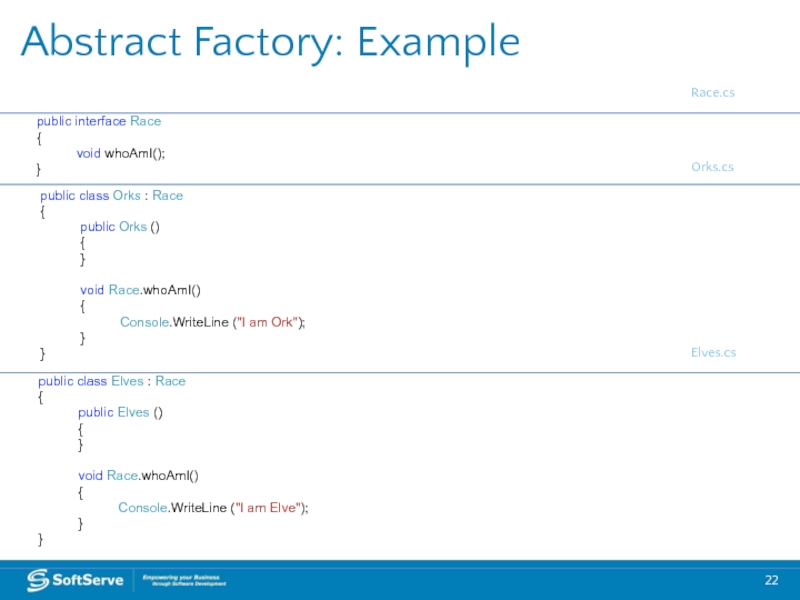
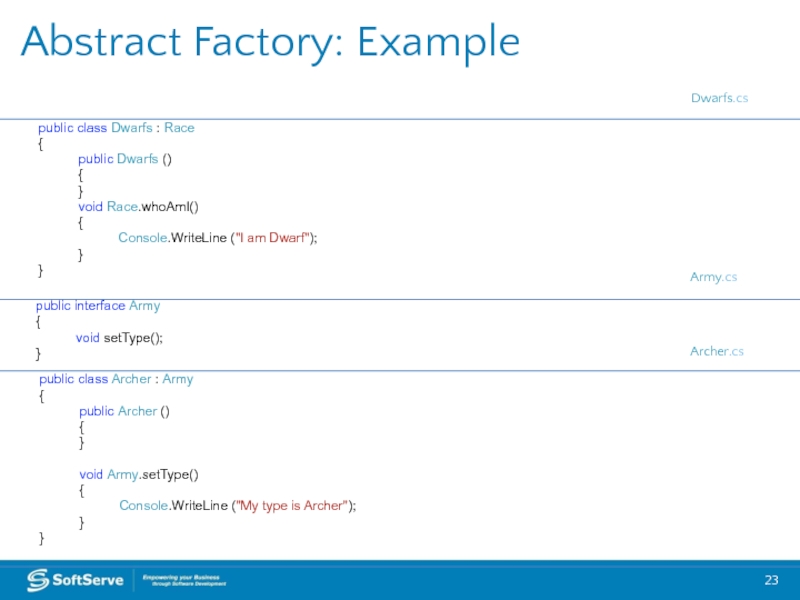
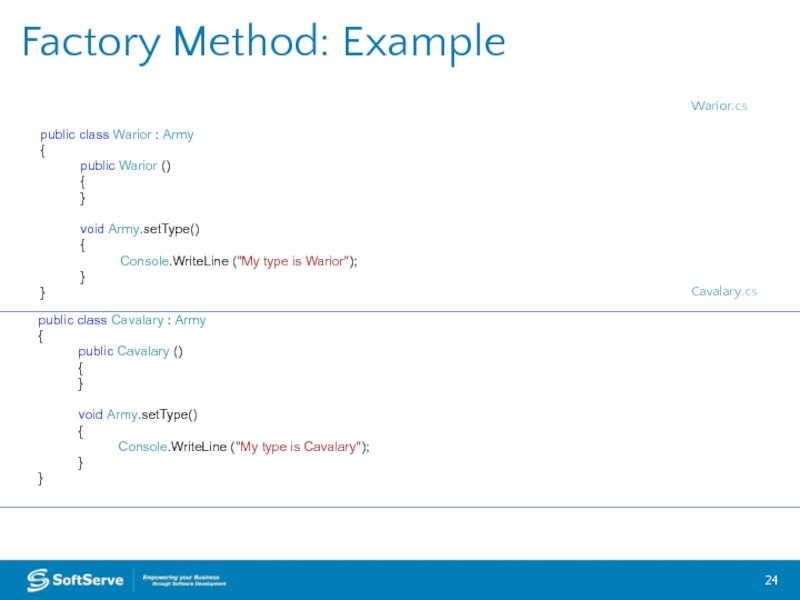
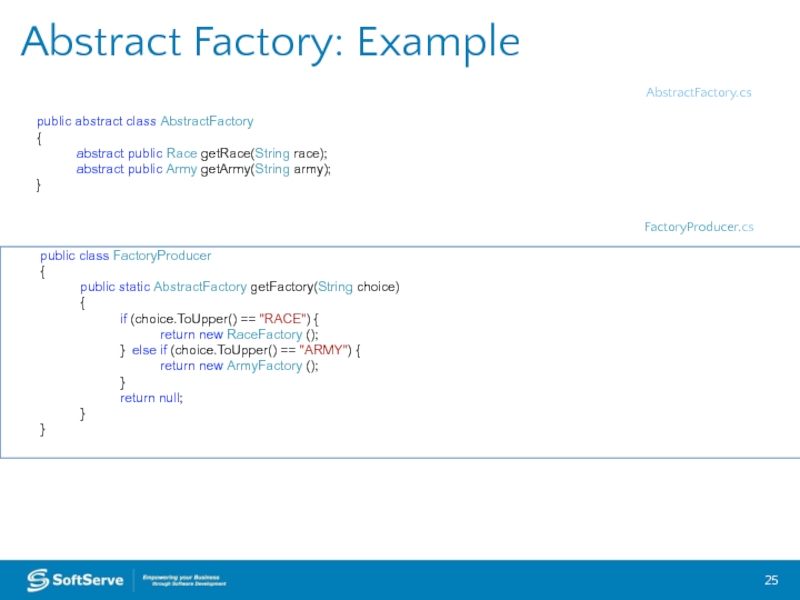
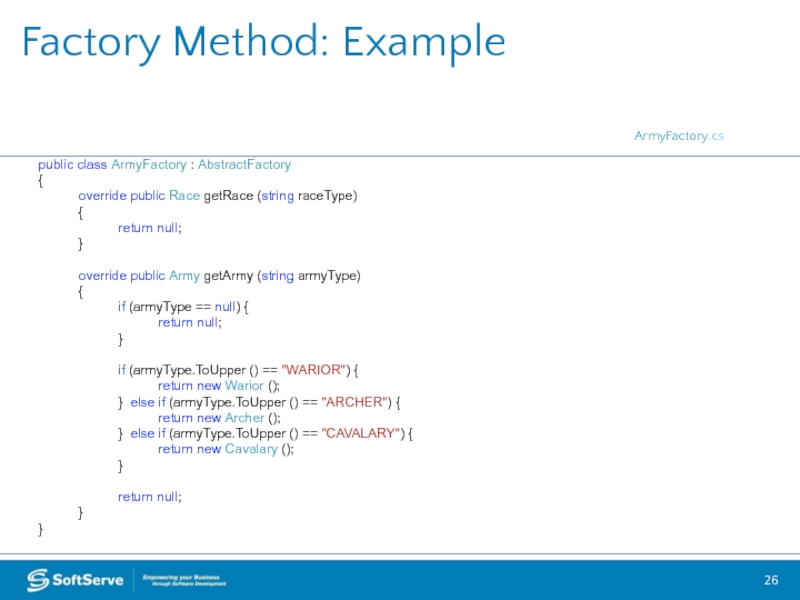
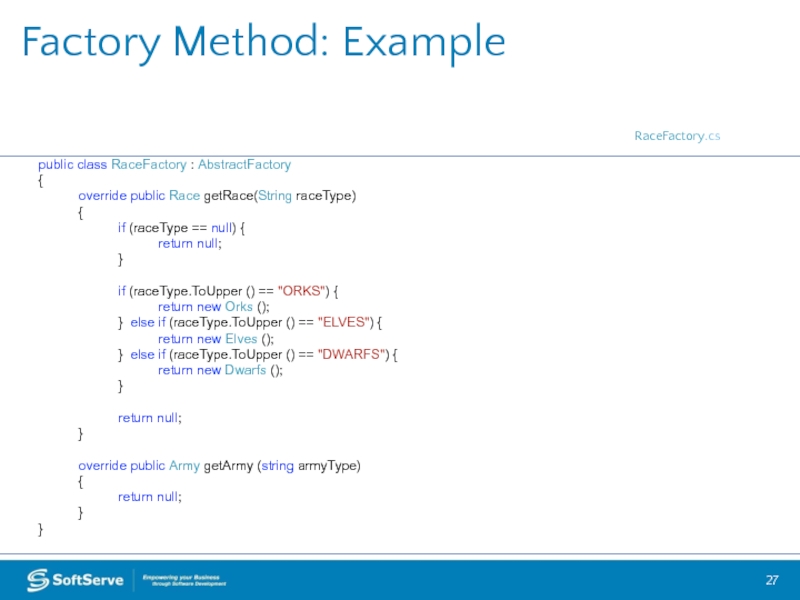
![Factory Method: Example class MainClass { public static void Main (string[] args) { AbstractFactory raceFactory =](/img/tmb/5/441973/d5a0268c14fe13b1f897200bb55f109c-800x.jpg)
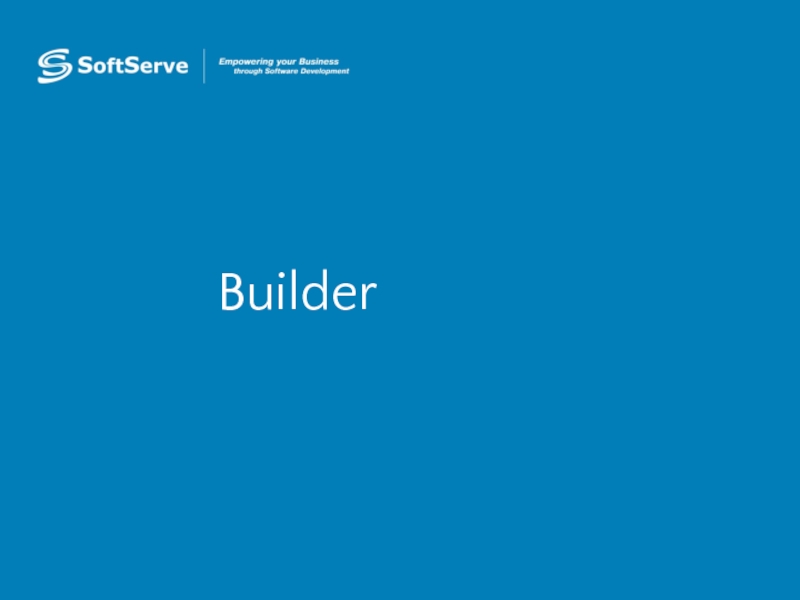
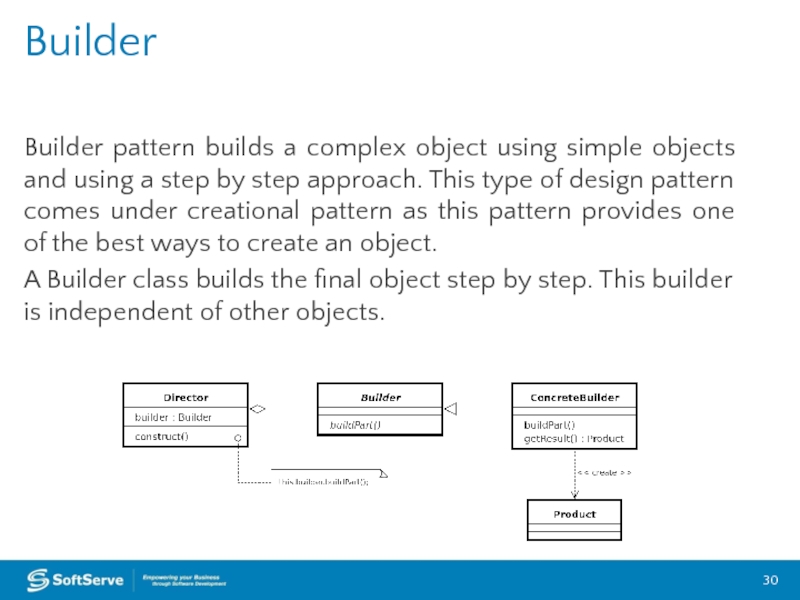
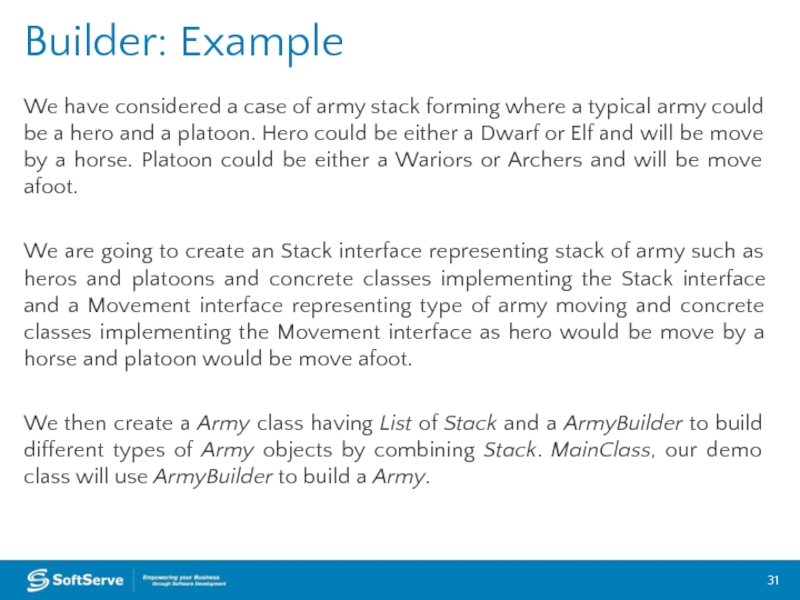
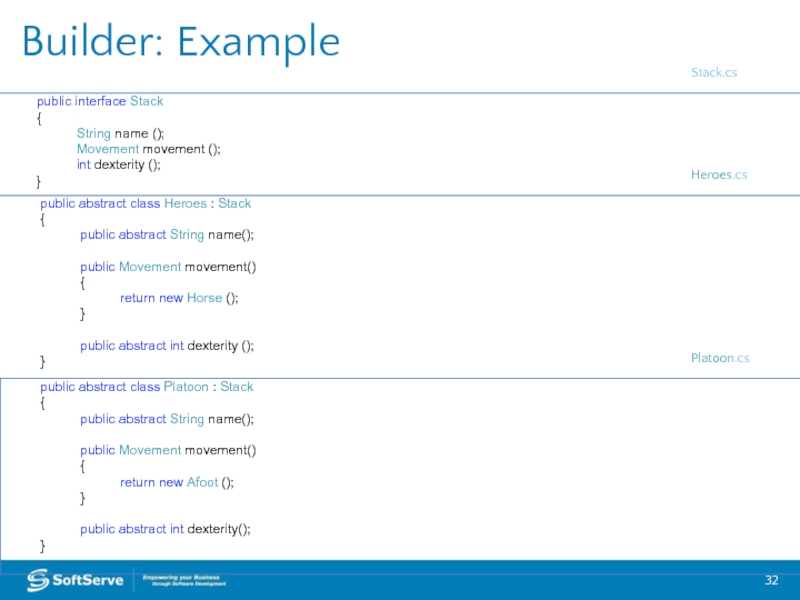
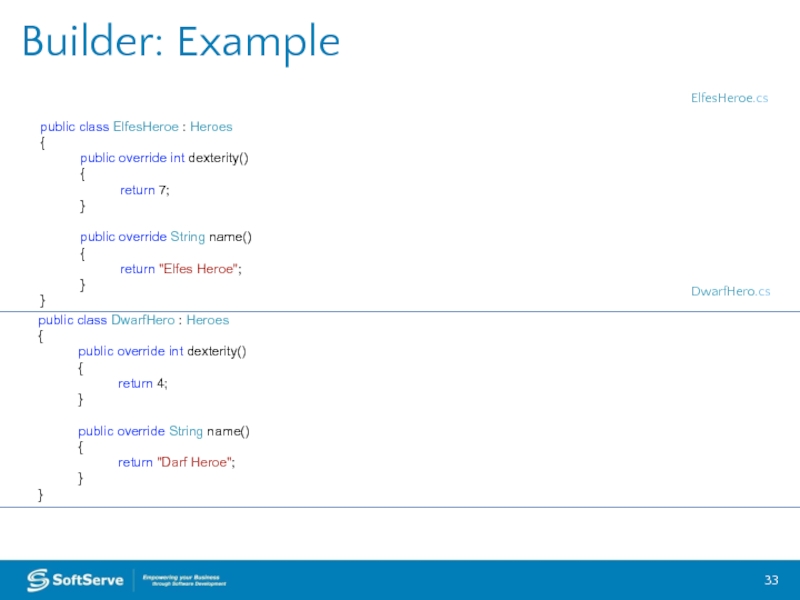
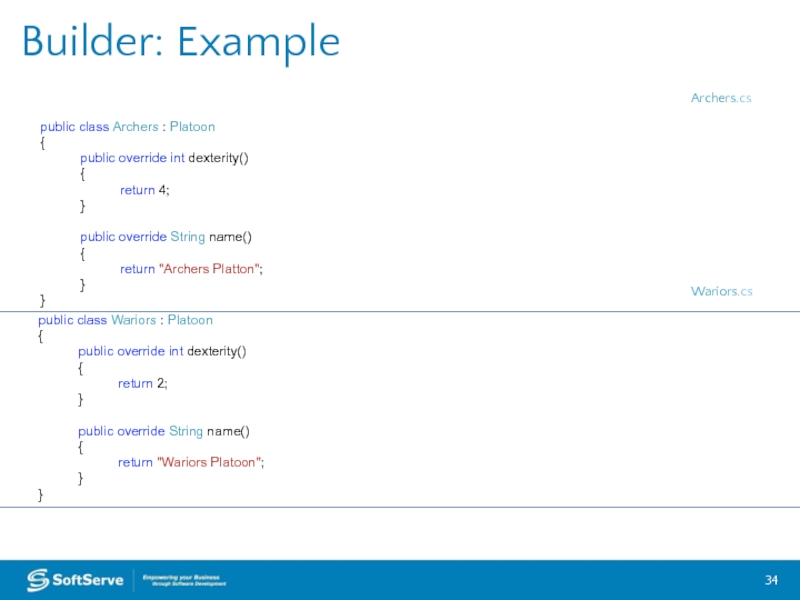
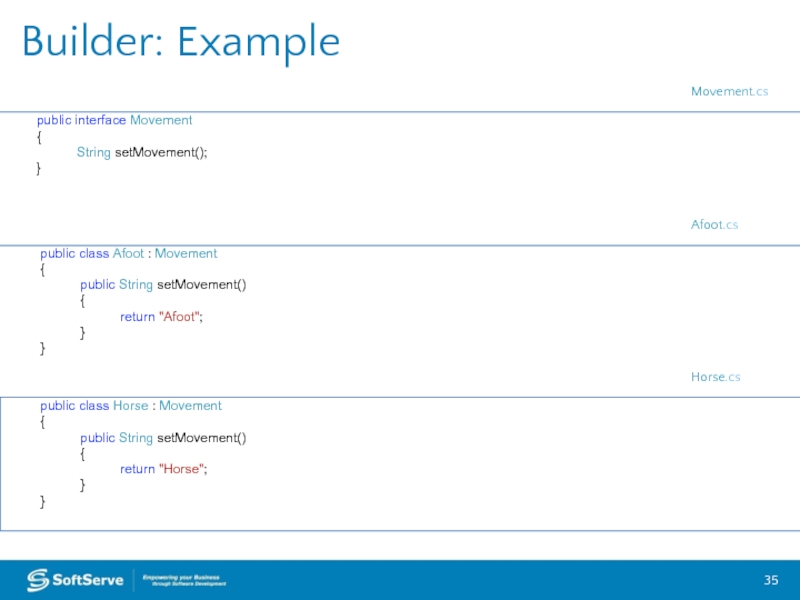
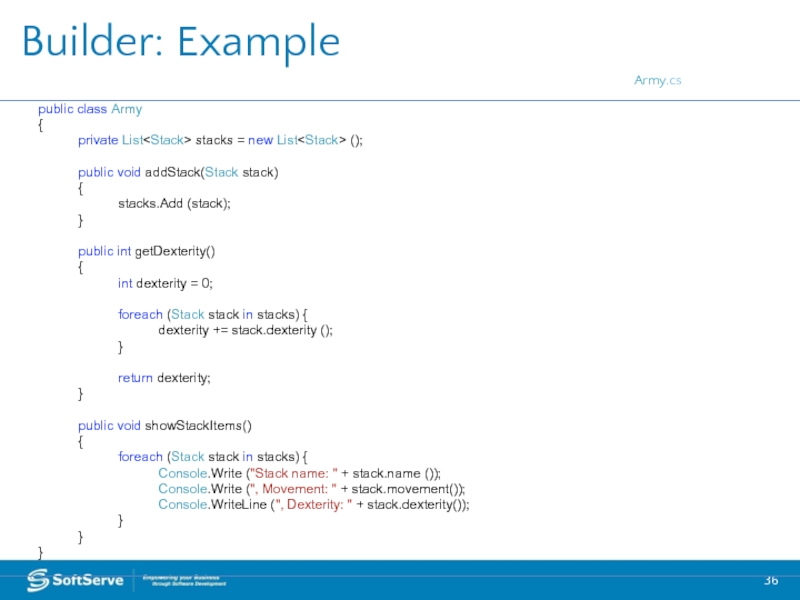
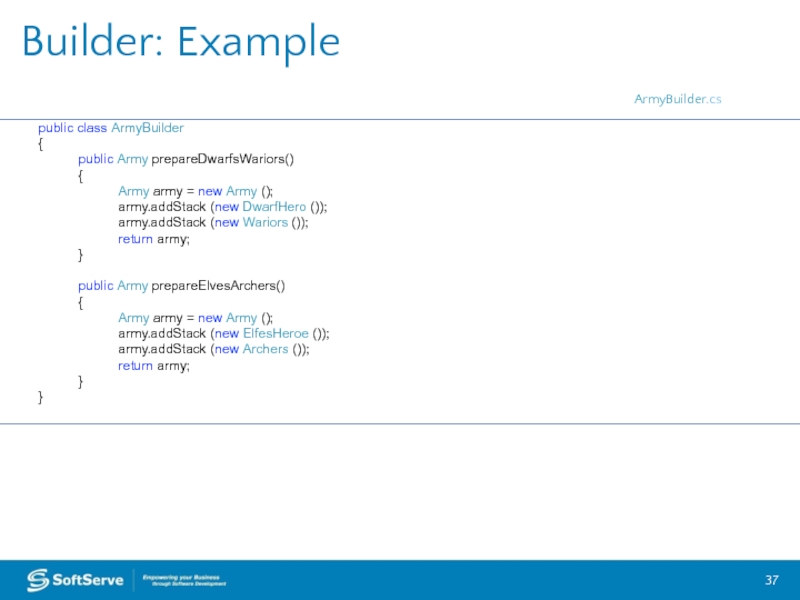
![Builder: Example class MainClass { public static void Main (string[] args) { ArmyBuilder armyBuild = new](/img/tmb/5/441973/33ec030fc5af7bc850a549c4cc8e84f0-800x.jpg)
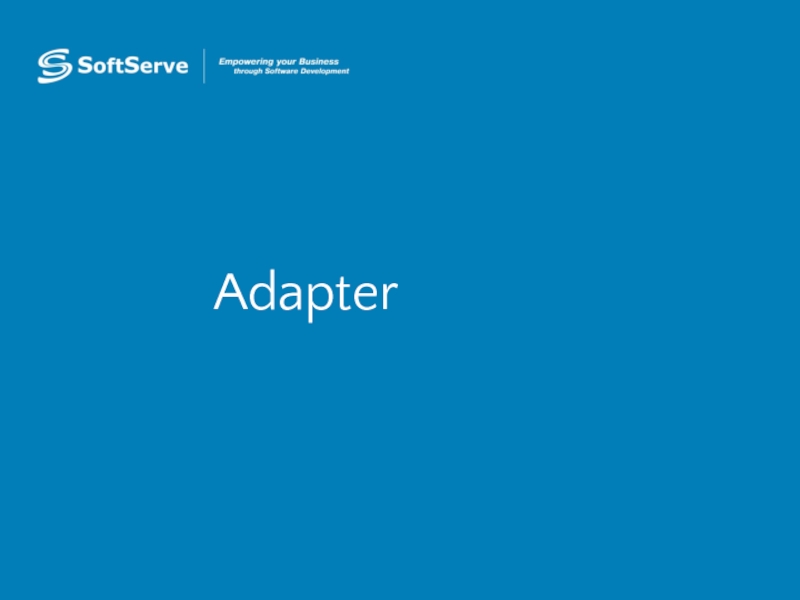
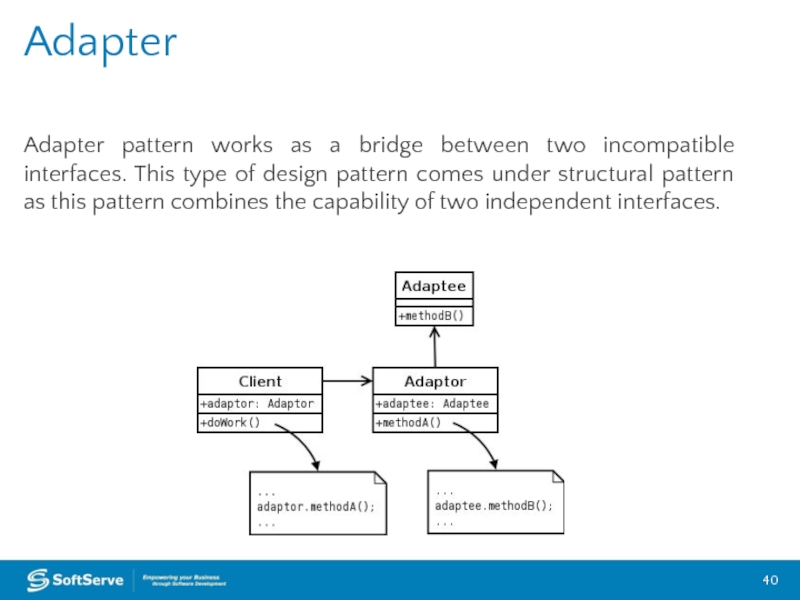
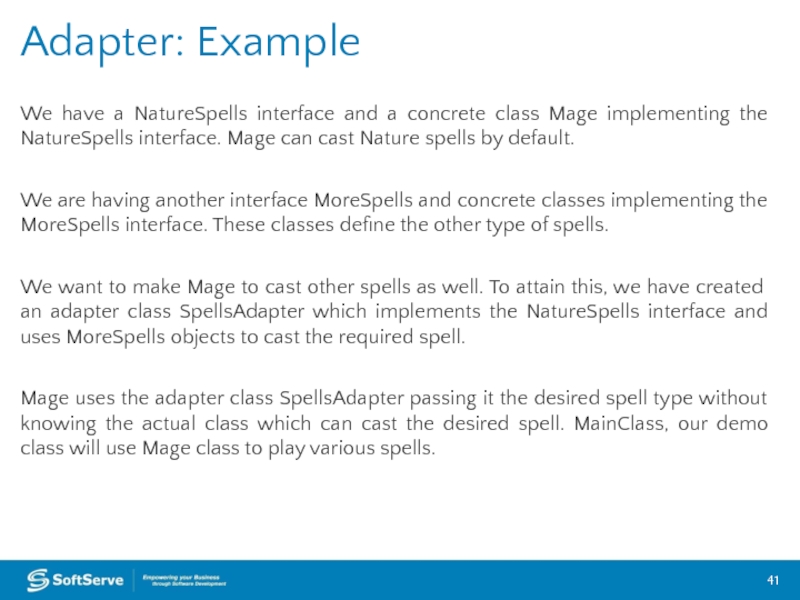
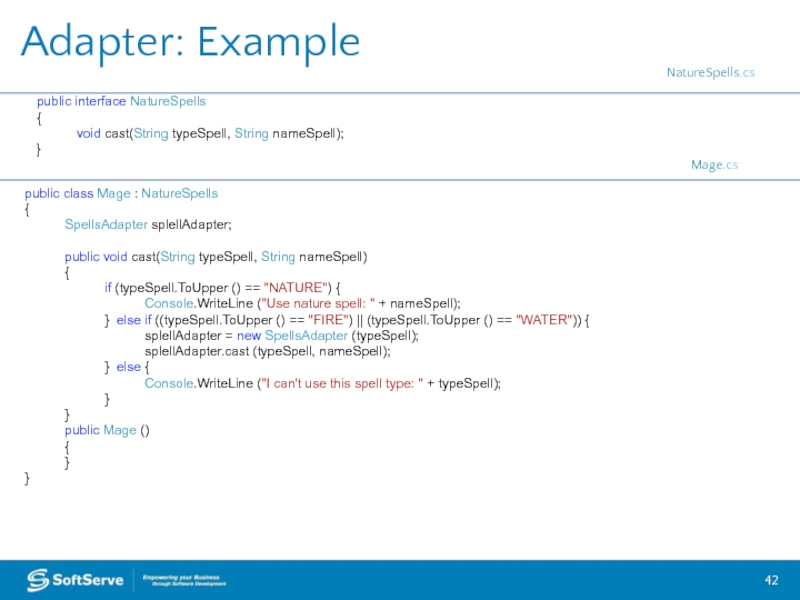
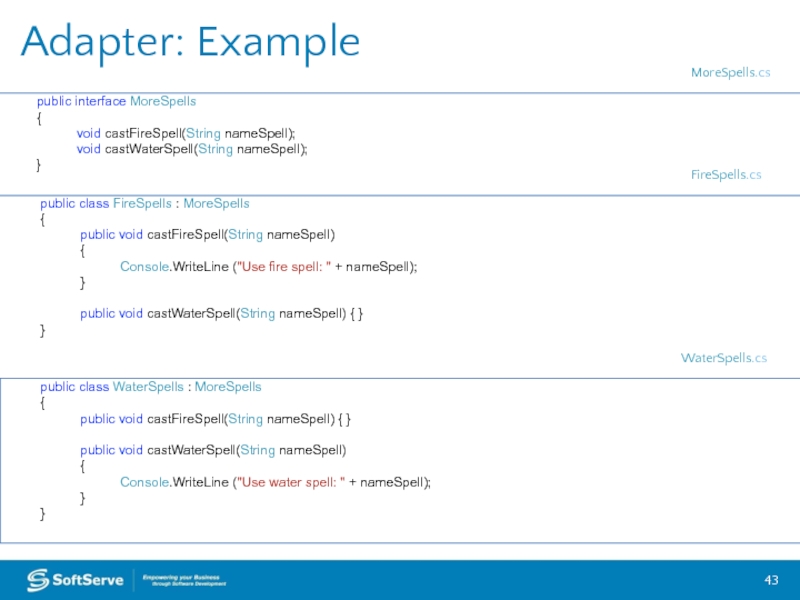
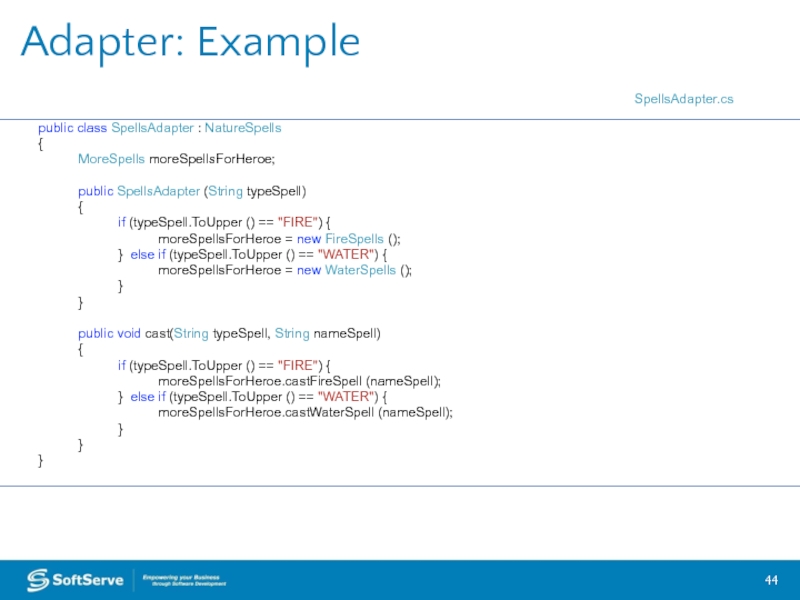
![Adapter: Exampleclass MainClass { public static void Main (string[] args) { Mage greatMage = new](/img/tmb/5/441973/867fcc7f640d47c06fc0bc921e341948-800x.jpg)
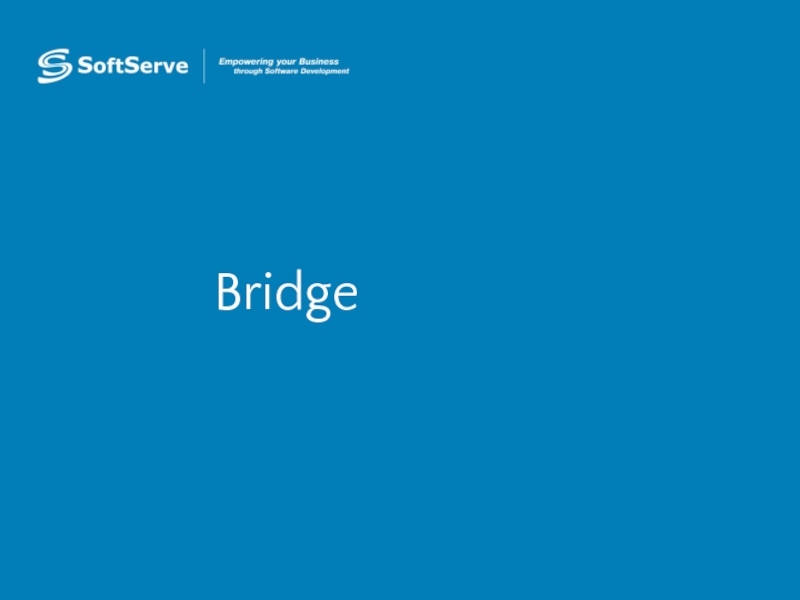
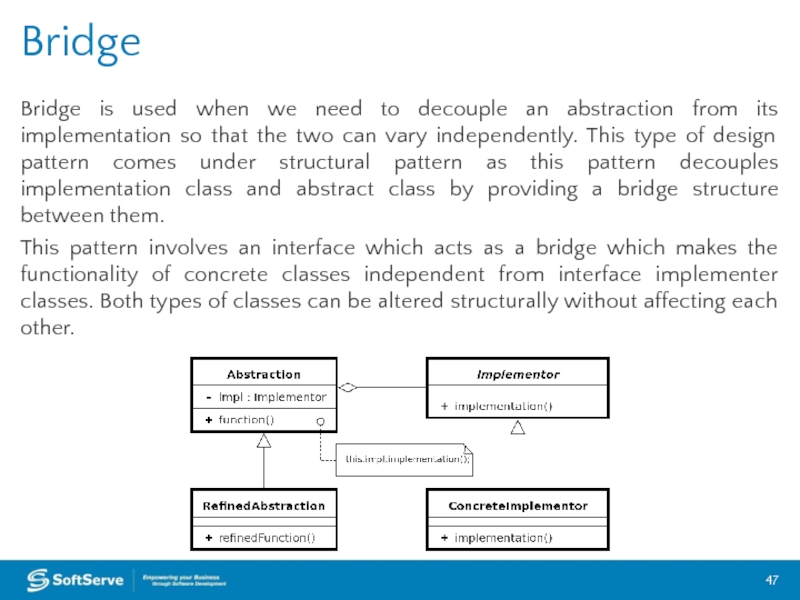
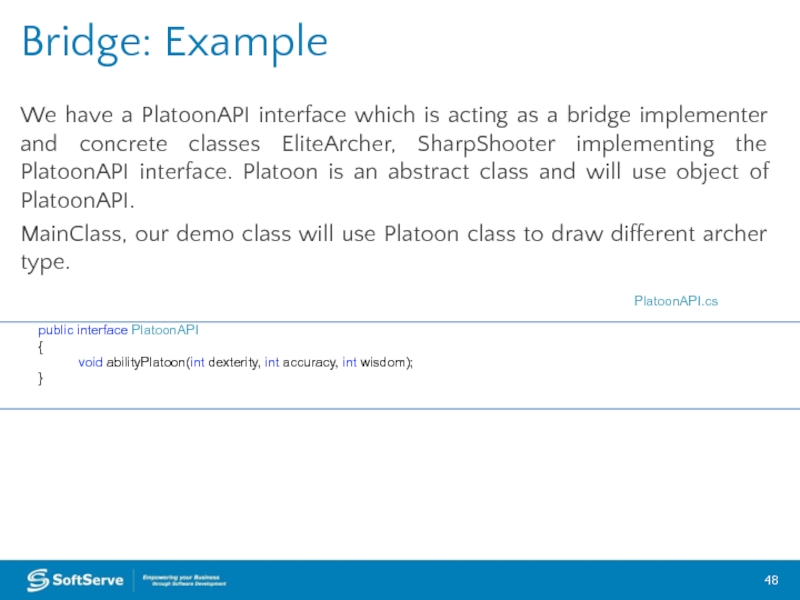
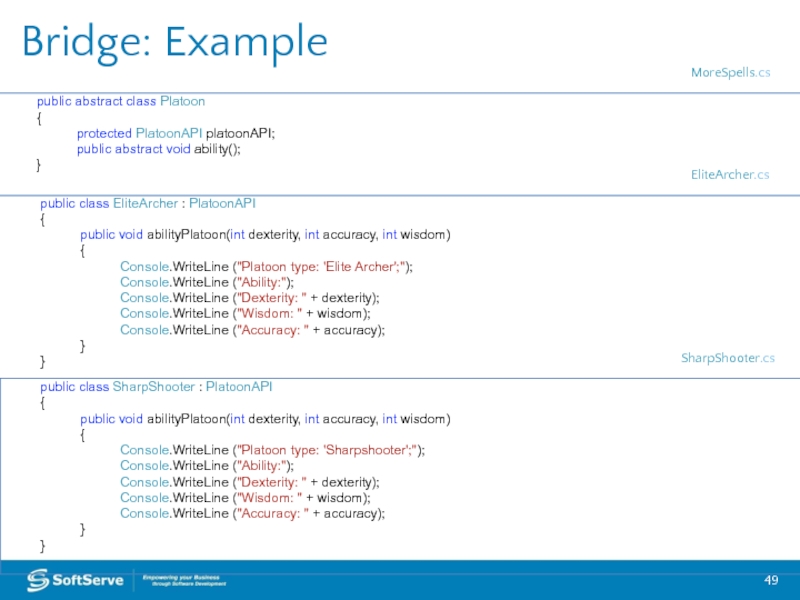
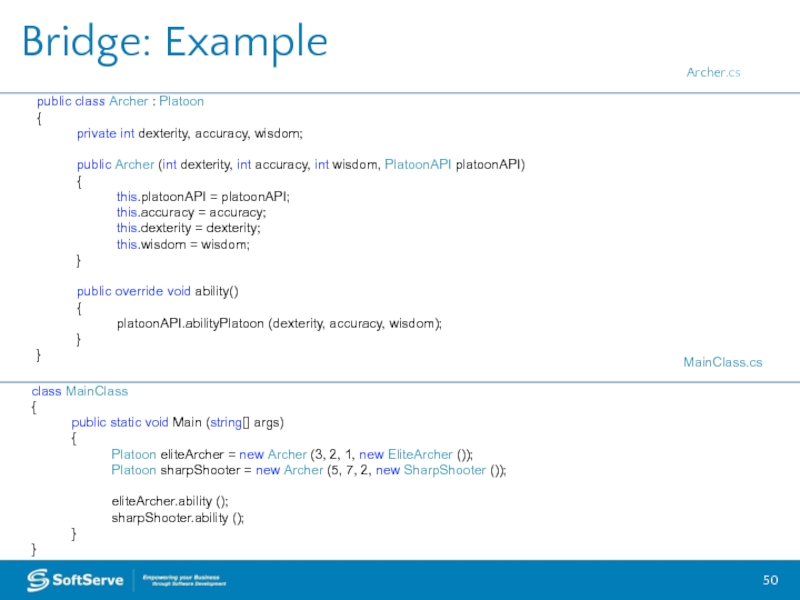
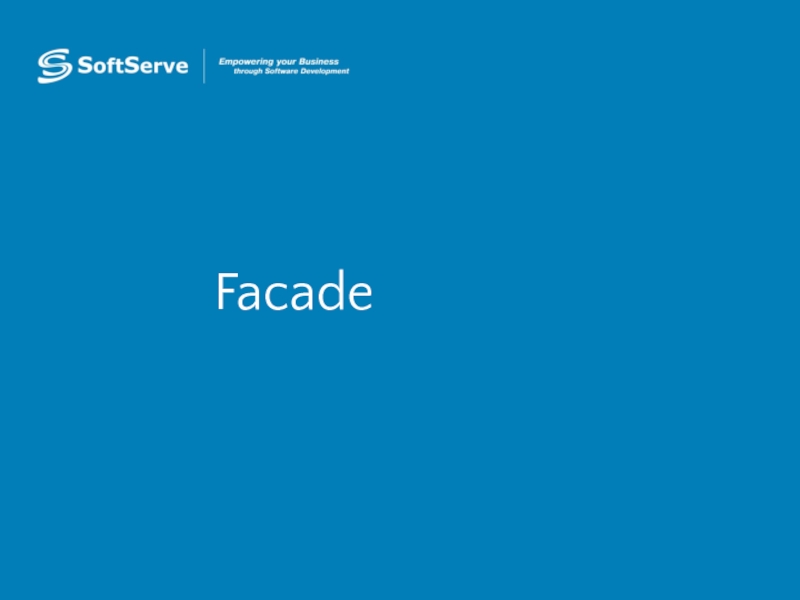
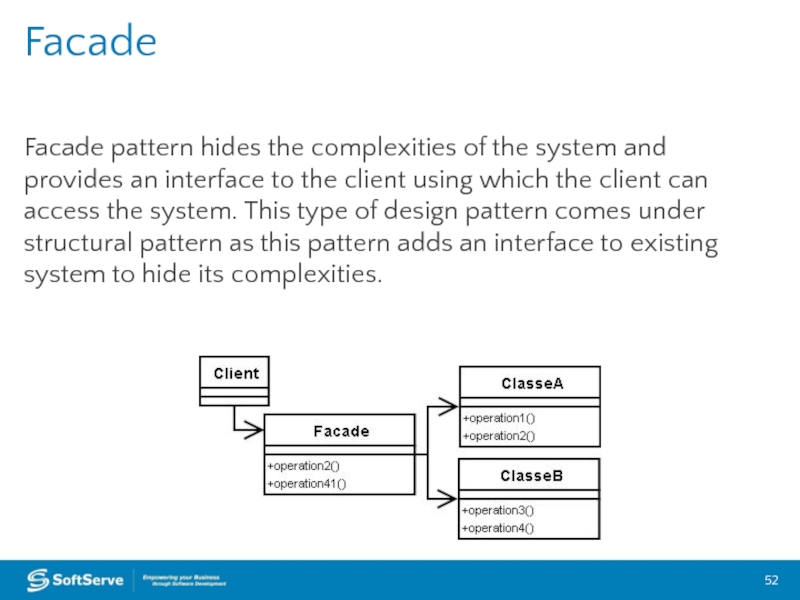
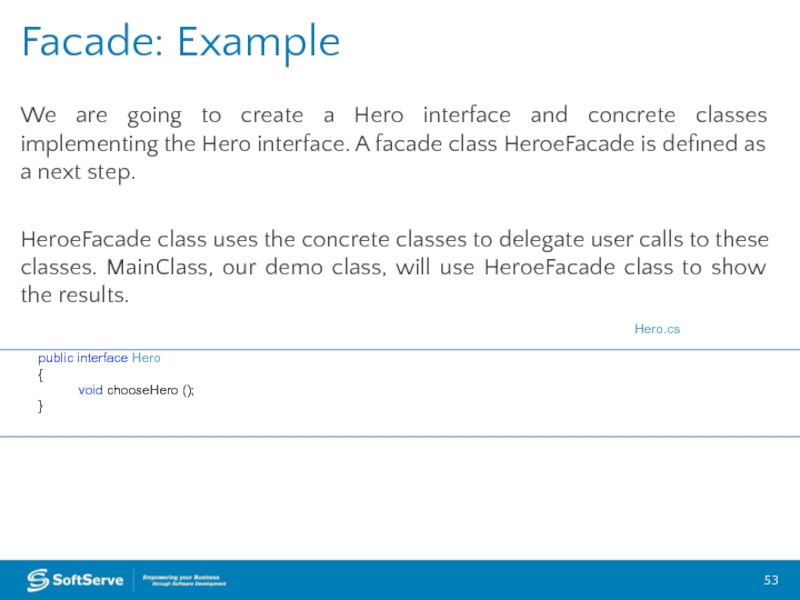
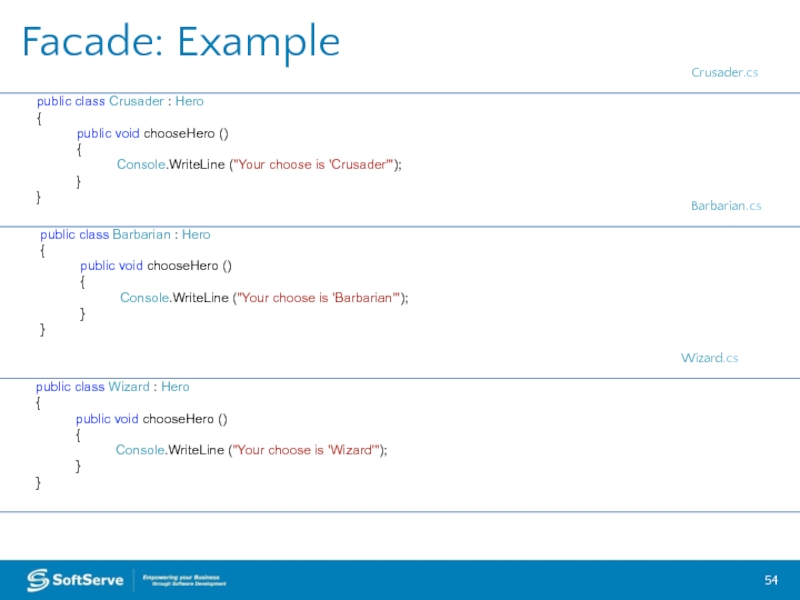
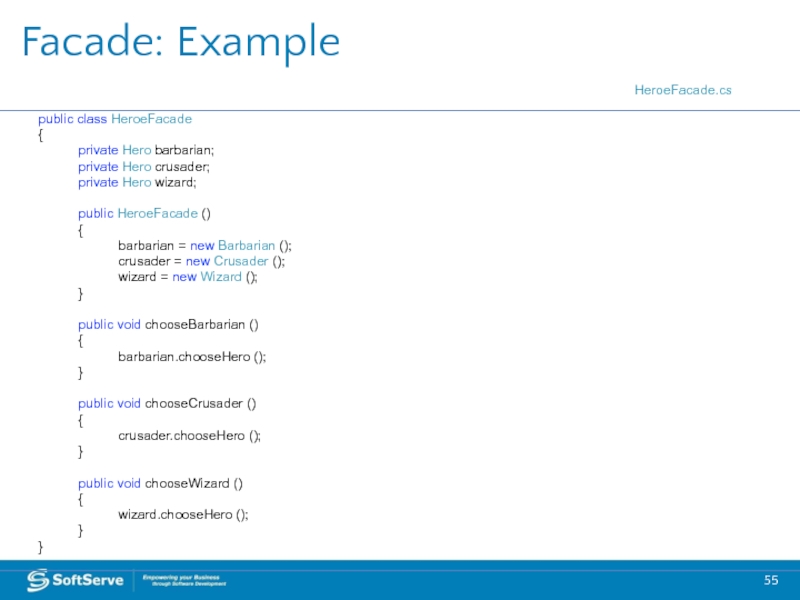
![Facade: Example class MainClass { public static void Main (string[] args) { HeroeFacade facade = new](/img/tmb/5/441973/ac6ab805ae78af9ae34c856475513722-800x.jpg)
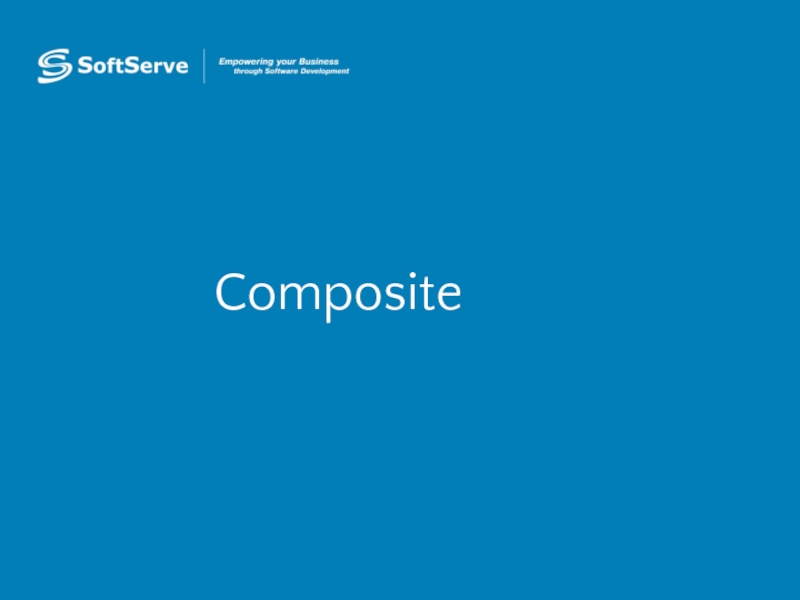
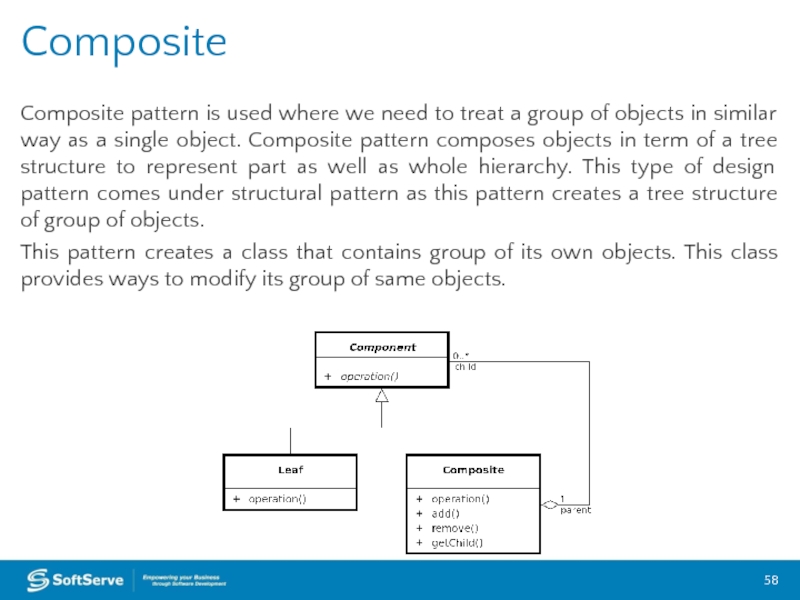
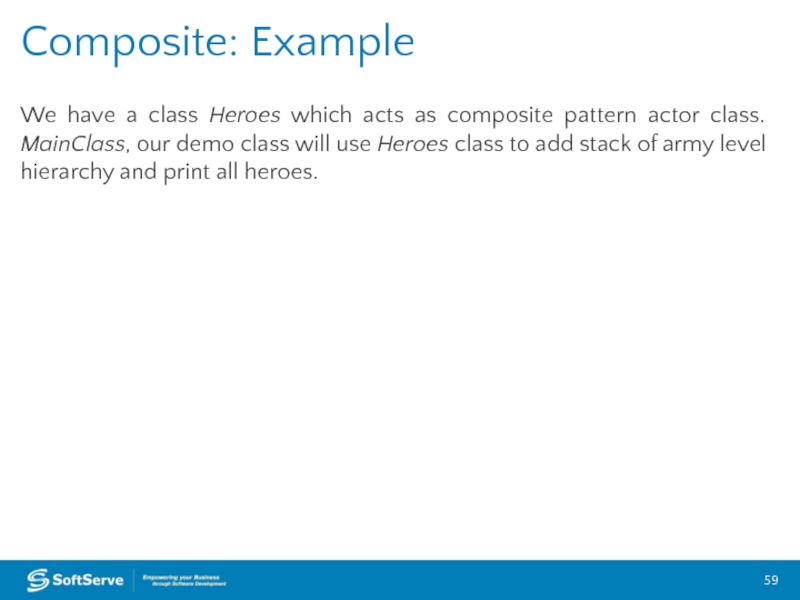
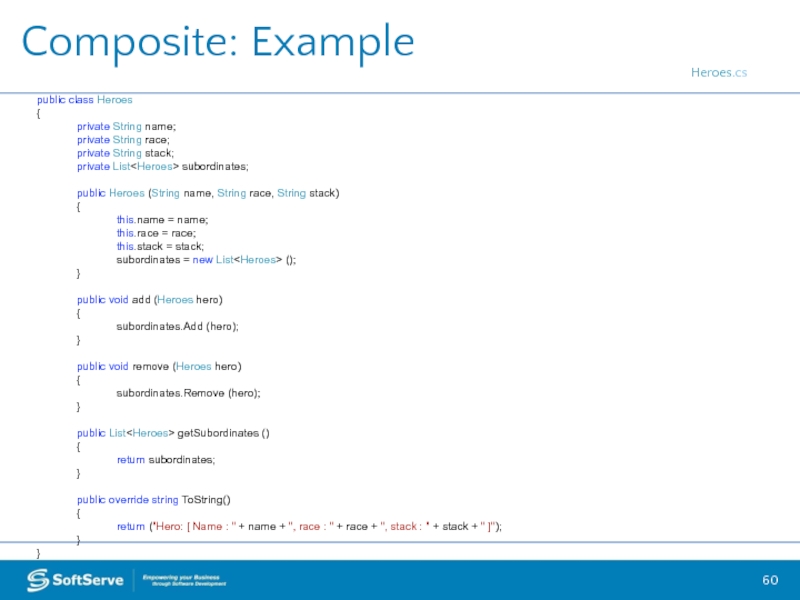
![Composite: Example class MainClass { public static void Main (string[] args) { Heroes armyCommander = new](/img/tmb/5/441973/077ea652f7a6b5b1e280dc2a4caf3fec-800x.jpg)
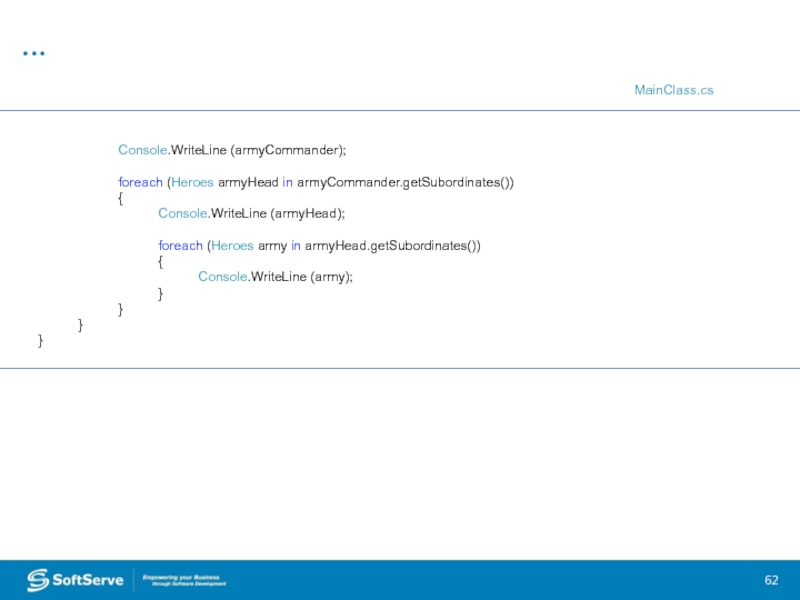
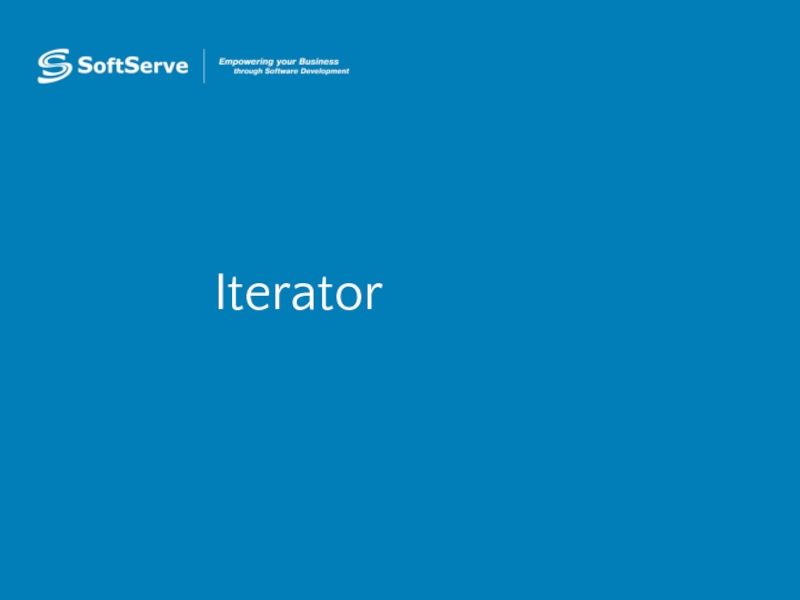
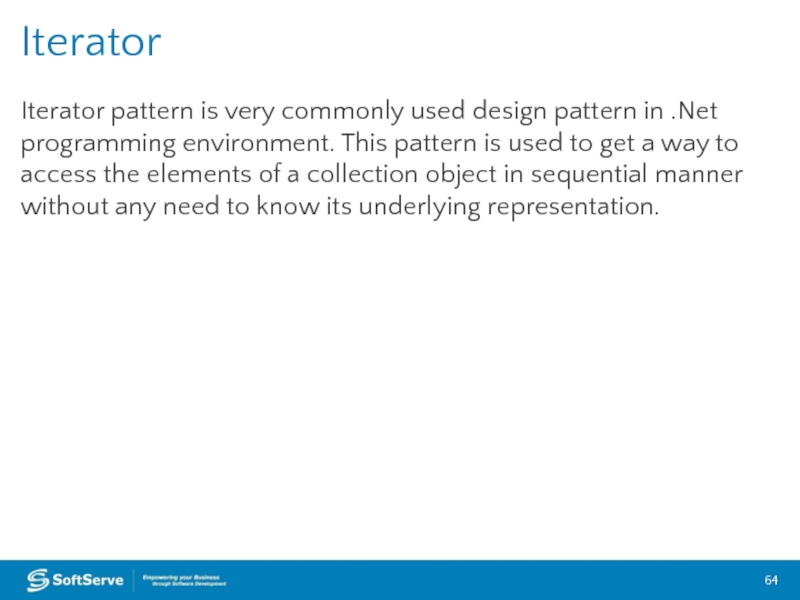
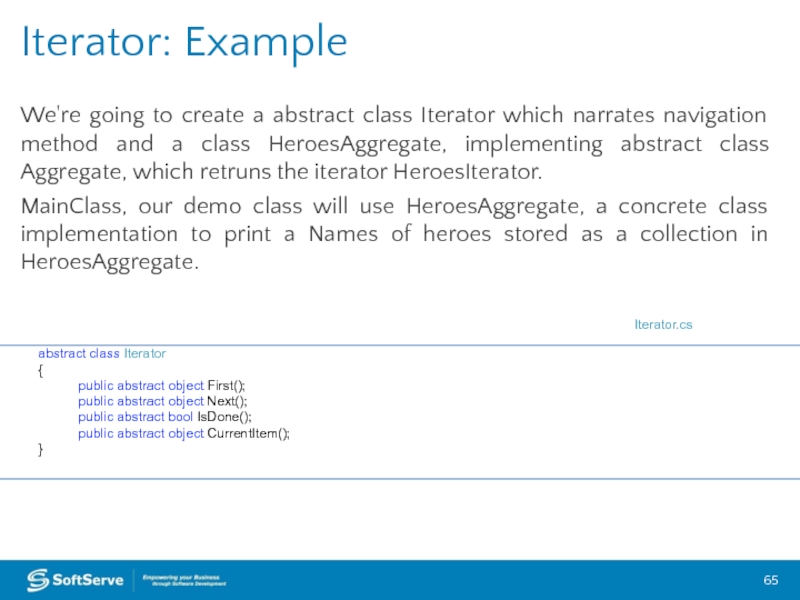
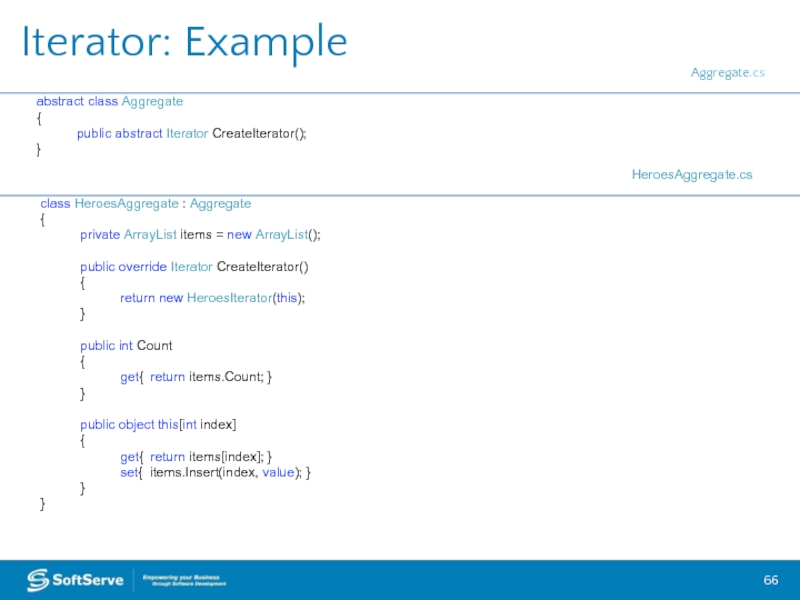
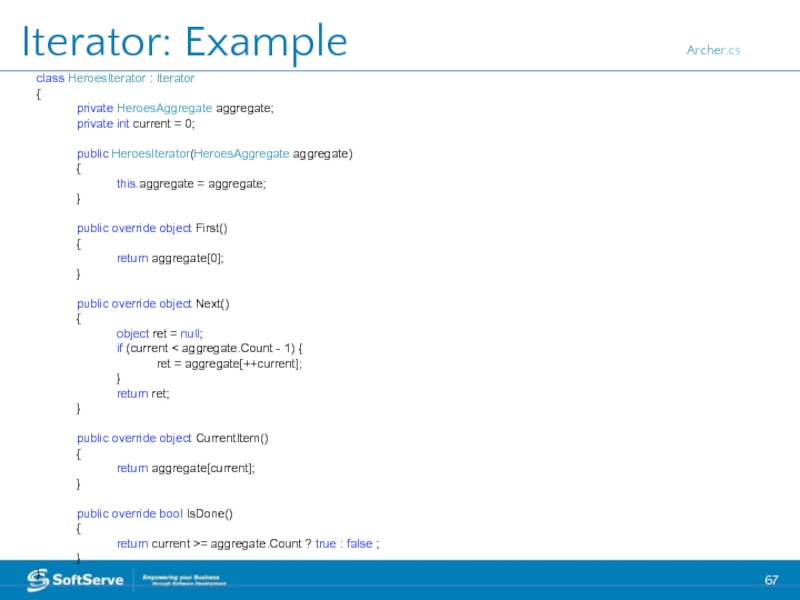
![Iterator: Example class MainClass { public static void Main (string[] args) { HeroesAggregate heroesStack = new](/img/tmb/5/441973/cf0372e65b23c6c0703f1ac194f8c84f-800x.jpg)
